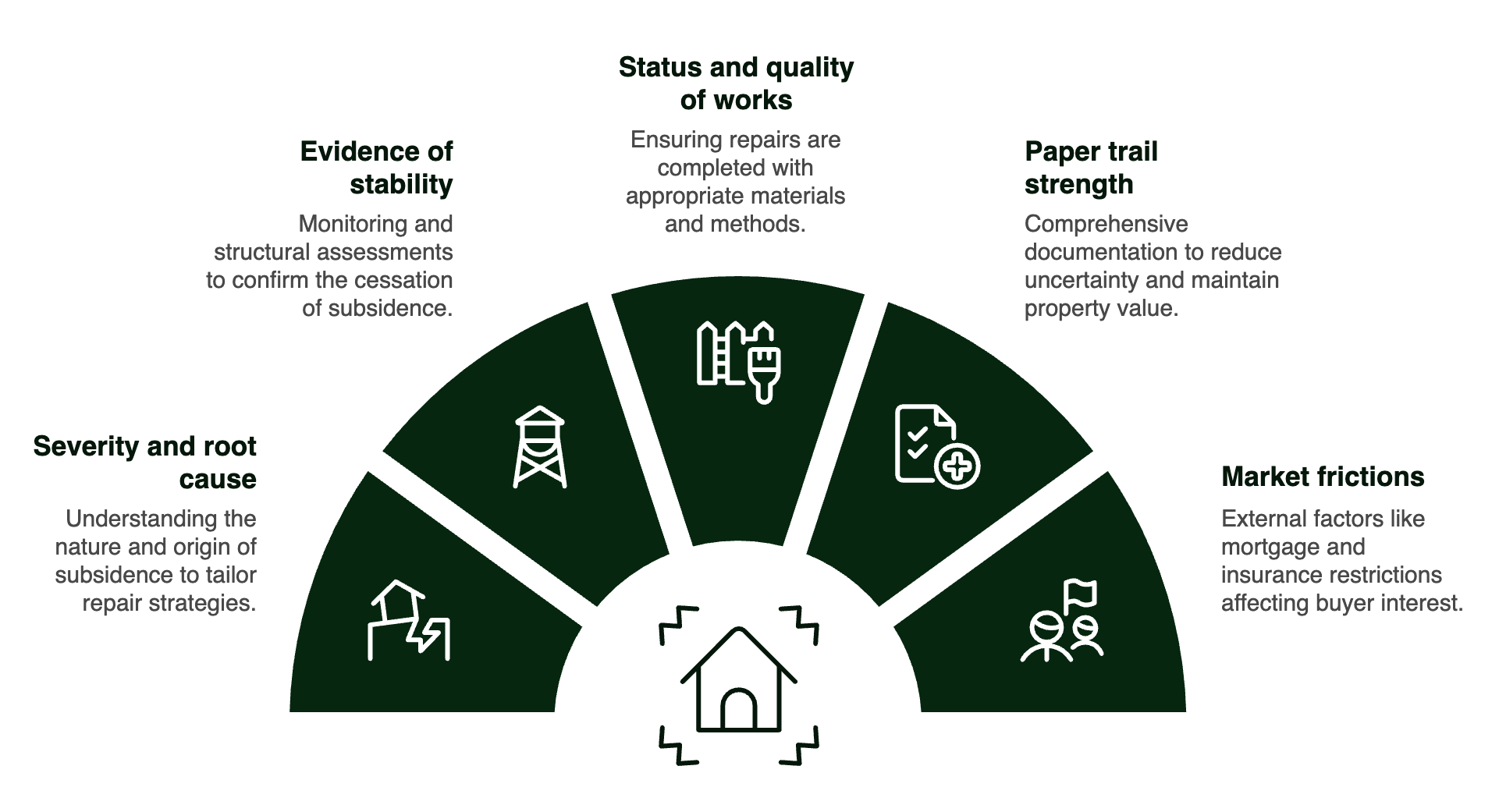.jpg)
How Much Does Subsidence Devalue A Property?
In the UK, active or recently confirmed subsidence can significantly affect price until the cause is fixed and stability is evidenced; the impact varies case by case depending on cause, severity, and documentation. Where works are complete and a structural engineer’s report and completion paperwork exist, discounts often shrink to single digits.
In severe cases, properties may be unmortgageable and sell only to cash buyers at deep discounts, or require extensive works/demolition.
While rivr can’t insure homes with existing subsidence, our high value home insurance covers future subsidence, heave and landslip up to £3 million with fast, easy digital claims.
What is subsidence?
Subsidence means downward movement of the ground beneath a building, which can distort the property’s foundations and finishes. It is not the same as general settlement after construction or routine shrinkage of plaster. In practice, subsidence occurs when the soil loses support, water changes conditions, or external factors disturb the ground.
Common UK causes
- Clay shrink and swell in hot or wet weather that dries or saturates the soil.
- Tree and shrub roots removing moisture near shallow foundations.
- Leaking drains softening the soil beneath bearing walls.
- Made or poor ground, or old mining activity.
Buyer-visible warning signs
- Stepped, diagonal cracks that are wider at the top than the bottom and over ~3 mm in width in masonry or plaster.
- Doors or windows sticking, and uneven floors.
- Rippled wallpaper or gaps opening at skirting and frames.
How much value does subsidence typically knock off?
Because buyers price in uncertainty, surveys, and subsidence repair costs, headline discounts vary with the specifics of the property and evidence available rather than following a fixed percentage. Where monitoring shows no ongoing subsidence and paperwork is strong, the reduction can be much smaller, sometimes only a few percentage points. Conversely, where risk remains unclear, offers fall sharply and marketing periods lengthen.
In very severe cases with major structural damage or unresolvable ground conditions, some properties become unmortgageable. They may sell only at deep discounts (or not at all) so a few sellers see extreme outcomes rather than a neat average. Lender appetite and insurer terms weigh heavily on the number of potential buyers willing to proceed.
Typical % impact by scenario
What drives the discount up or down?
Five levers tend to move the needle on how much subsidence devalue a property: severity and root cause, evidence of stability, repair status and certification, the strength of the paper trail, and market frictions such as lender and insurer appetite in that postcode. Each one influences how comfortable potential buyers feel about structural integrity and future risk.

1. Severity and root cause
Clay shrinkage in dry spells versus a failed drain or historic mining can imply different risk profiles and designs to repair subsidence. Buyers will scrutinise whether the ground beneath has stabilised.
2. Evidence of stability
Monitoring that shows no ongoing subsidence over a reasonable period, and a structural engineer’s summary tied to photos and dates, narrows the discount. RICS notes monitoring may be needed for up to 12 months, or longer in some cases, to confirm stability.
3. Status and quality of works
Completed subsidence repair with specified materials and an appropriate underpinning method is persuasive, particularly where completion certificates and guarantees are included.
4. Paper trail strength
An engineer’s report, invoices, guarantees, and confirmation of insurer continuity following any subsidence claim reduce uncertainty that otherwise can devalue a property.
5. Market frictions
Some buyers need a mortgage and some insurance providers restrict terms following claims or apply higher excesses, which shrinks the buyer pool. Cash buyers widen options but often expect a keener price.
Typical UK repair cost ranges
Reviewed 3 November 2025
The figures above are broad indicators, not quotes. A chartered structural engineer should specify the most suitable underpinning method and contractors should price against that design. According to RICS, fewer than 5% of subsiding properties require underpinning and that underpinning should be a last resort.
Beyond those ranges, cost factors include the number of professionals involved, the size of the house, the location, and whether specialist piling rigs are required. Where mini piles are used, budgets often reference a per pile figure.
Lenders, insurers, and the “paperwork premium”
Documentation changes outcomes because it lets lenders, insurers, and buyers assess whether structural issues are resolved and whether ongoing subsidence is likely. Strong evidence improves confidence, which directly influences offers, mortgage availability, and house insurance terms such as excess or exclusions after an insurance claim.
What lenders want to see
- A chartered structural engineer report explaining cause, extent, and recommended rectifying subsidence works.
- Evidence of stability through monitoring logs over a suitable period.
- Proof of completed remediation and specification, including invoices and guarantees.
How insurers look at it
Insurers often treat properties with subsidence history as higher risk, may apply a specific excess, limit insurance coverage for future movement, or seek continuity at renewal after works are complete. Wording varies by policy, so written confirmation matters when you disclose history to potential buyers.
For formal definitions, many policies define subsidence as downward movement of the ground beneath the buildings, which guides when cover triggers and which exclusions apply. Always check your buildings insurance schedule and policy wording.
Underpinning: stigma versus reassurance
Underpinning work does not automatically depress value. The key is whether the underpinning method matches the cause and soil beneath, and whether the design and paperwork give comfort that no ongoing subsidence persists. Correctly designed mass concrete underpinning or mini piled solutions can restore structural safety and confidence when monitored and certified.
Some buyers still worry about stigma, yet others welcome a well documented solution because it reduces future uncertainty. Price impacts therefore vary depending on communication and the strength of the evidence pack. In short, the better the paperwork, the closer you stay to full market value.
Simple value-impact calculator
Estimate how much subsidence could affect a property’s market value. Enter the estimated repair cost, current sound value, and a risk tier to see a quick rule-of-thumb devaluation and an adjusted value range.
How to recover value and sell smoothly
.png)
- Diagnose: Commission a structural engineer to identify the cause and define the most suitable underpinning method or other remedy. Add photos and a plain English summary.
- Monitor: If appropriate, monitor for movement to demonstrate that ongoing subsidence is not present before major works. Keep a dated log.
- Remed: Follow the specification. For example, drain repair or lining for leaks, or underpinning work where deeper foundations are required. Options include the mass concrete method, mini piling, or resin injection.
- Document: File invoices, guarantees, and a completion certificate to present to an estate agent and buyers. This paper trail reduces perceived risk.
- Insure: Seek continuity with the same insurer after a subsidence claim where possible, and keep all correspondence for buyer packs.
- Disclose: Complete the seller’s TA6 form accurately and share your evidence pack proactively. Failure to disclose subsidence issues can be costly.
Remember, selling routes vary. A private treaty sale with full documentation generally preserves more value. Specialist cash buyers can progress a house with subsidence where lenders hesitate, though price expectations reflect risk and works still required. Auction provides speed where major subsidence makes traditional lending unlikely.
Evidence pack checklist
Resources
Understand subsidence & typical processes
Get professional help
Lenders, conveyancing & disclosure
Insurance & claims
- ABI: Subsidence and home insurance
- BIBA – Find Insurance/Broker
- Citizens Advice: Making an insurance claim
Ground risk & trees
Read more
Frequently asked questions
There’s no standard %. Impact is case-by-case and depends on cause/severity, evidence of stability (monitoring/engineer reports), and whether lenders/insurers will accept the risk. Fixed “typical” discounts aren’t published by UK authorities; lenders instruct conveyancers case by case.
It can be harder if the cause is unresolved or paperwork is weak. Sales are more straightforward when you can show a chartered engineer’s report, monitoring demonstrating stability, and completion/insurance continuity documents. Some properties with ongoing issues may be unmortgageable and sell to cash buyers instead
Sometimes, yes, if the cause is diagnosed and remediated, stability evidenced, and documentation is strong. You must receive full disclosure via the TA6 form and assess lending/insurance terms before exchange. Consider an independent chartered surveyor/structural engineer review.
Costs vary by cause and scope. Underpinning (when needed) for a typical house is often £10,000–£75,000+ and is a last resort used in <5% of cases; many problems are addressed by tree/drain remedies and localised repairs. Get an engineer’s specification and contractor quotes.
Yes. Typical steps: diagnose the cause, monitor where appropriate, remedy the cause (e.g., drainage repairs, vegetation management), and only underpin if necessary per an engineer’s design. Properly specified works usually stabilise the structure.
Usually yes if you need engineered investigation/repairs, buildings insurance typically covers subsidence but expect a higher excess (around £1,000) and potential changes at renewal. Insurers often look for continuity after a claim; keep all correspondence.
From first report to sign-off can span months to 12+ months. RICS explains movement may need monitoring for up to 12 months (or longer in some cases) before or after works to confirm stability; remedial works themselves are typically weeks to a few months depending on access and method.
The general rule is that you may need high-value home insurance if you meet any of the following criteria:
- The rebuild value of your home is over £1 million
- Your general contents are worth over £100,000
- You have valuable items that together are worth over £30,000






